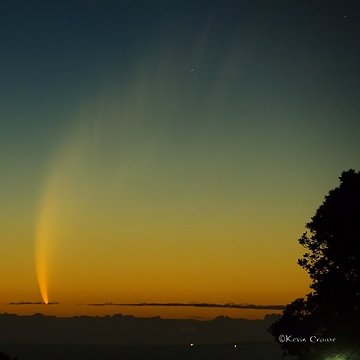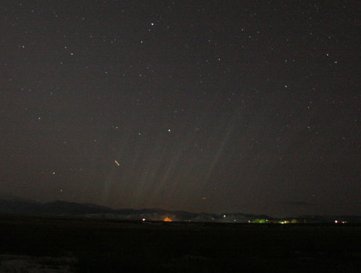 Did you sleep through the auroras of Dec. 14th? Next time get a wake-up call: Spaceweather PHONE.
Did you sleep through the auroras of Dec. 14th? Next time get a wake-up call: Spaceweather PHONE.
WISCONSIN AURORAS: Last night the sky turned green over Chippewa Falls, Wisconsin. "The auroras were faint, but it was a beautiful scene," says photographer Tony Wilder. The cause of the display: a solar wind stream is buffeting Earth's magnetic field. High-latitude sky watchers should remain alert for more auroras tonight
GREAT COMET: "Here in Argentina, Comet McNaught is a real hit. It's a wonderful sight after sunset," reports Mariano Ribas of Buenos Aires. "The comet's magnitude is around -3, and its bright and curved tail is easy to see with the naked eye: image."
The comet is widely visible from all parts of the Southern Hemisphere. This Jan. 17th photo comes from Kevin Crause of Mossel Bay, South Africa:

Photo details: Nikon D2X, 120mm lens, f/5.3, 9sec, ISO 200
Comet McNaught Photo Gallery
[finder chart] [ephemeris] [orbit] [comet binoculars]
Look at the photo, above: McNaught's dusty tail is curved. Why? Because it traces the comet's curved orbit. The tail curves so much that it actually leads all the way back to the northern hemisphere where it can be seen glowing very faintly in the western sky after sundown.
Amateur astronomer Paul Robinson first spotted it on Jan. 16th from Boulder, Colorado: diagram. "The tail is very faint and resembles a pale aurora borealis," he says. One night later, Dan Laszlo of the Northern Colorado Astronomical Society took this picture:

Photo details: Canon 20D, ISO 1600, f/4, 17mm lens, 20 seconds
"As Paul Robinson described, the multiple streamers looked like faint auroral rays," says Laszlo. "The tail was visible in binoculars when Venus set."
These are extraordinary observations and astronomers elsewhere are encouraged to confirm them. "Find the darkest sky you can," Laszlo advises, "and look west between one and two hours after sunset. A site where you can see zodiacal light would be best." Try it!

